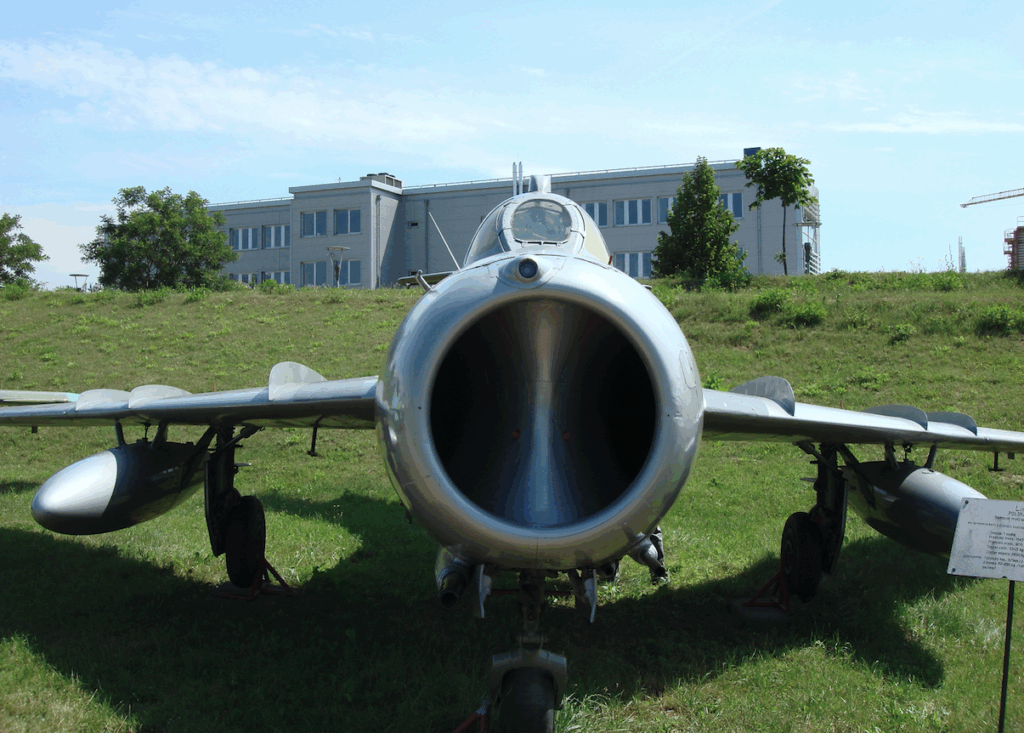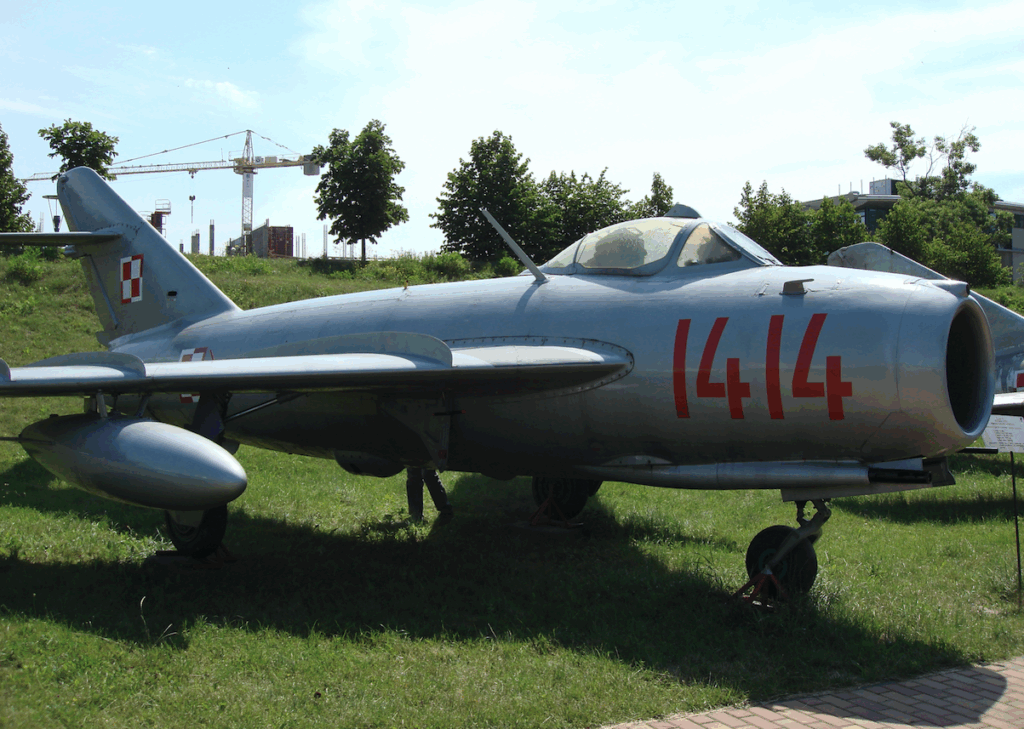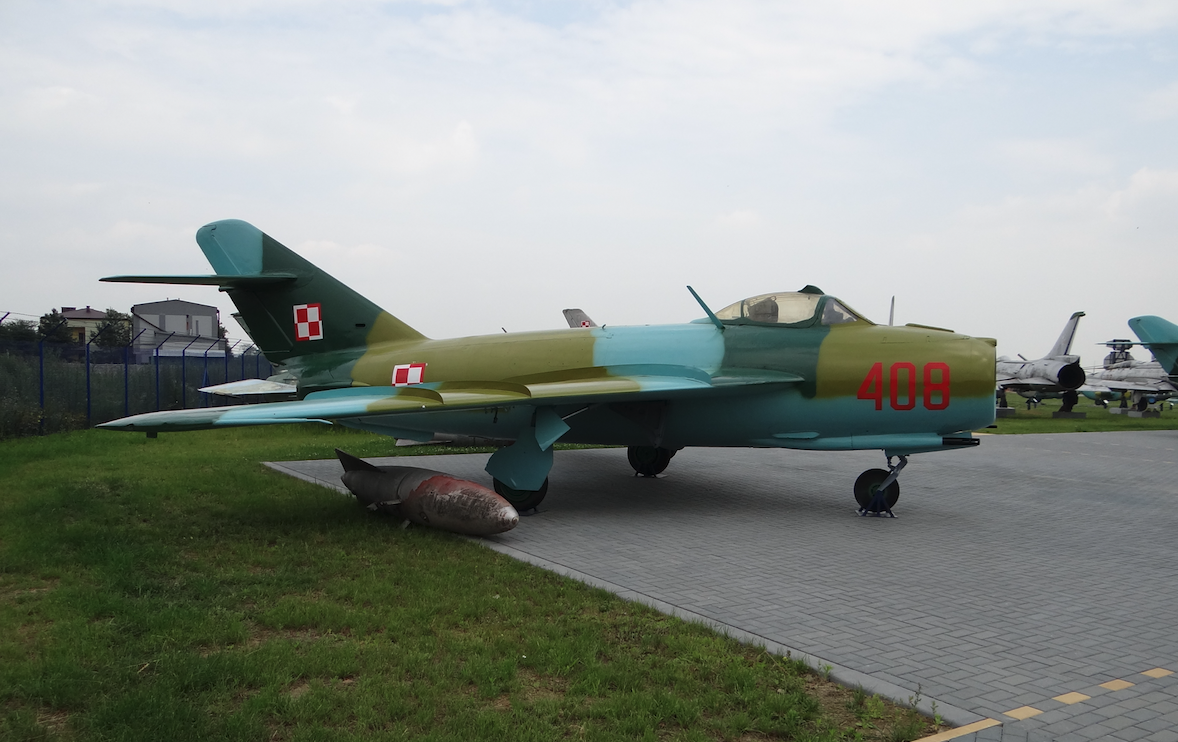Kraków 1.05.2007
140 Section 1956.05.25.
WSK Mielec MiG-17, Lim-5, Lim-5 P. History. 1956
Poland. Fighter aircraft.




History of the purchase of the MiG-17 1955.
The political situation had barely been brought under control, ending the bloody war in Korea, and already in the mid-1950s, it flared up again politically and militarily in Europe. On May 5, 1955, in connection with the ratification of the Paris Agreements, the Federal Republic of Germany was accepted into NATO structures. The Eastern Bloc, at a conference convened in Warsaw, under the leadership of the CCCP, established the Warsaw Pact. Its effect was the reorganization of armed structures, and especially their tasks and subordination. A further effect was the introduction of new equipment. Helicopters appeared. But not only.
In Poland, as part of the modernization of fighter aviation, the first batch of 12 MiG-17 PF aircraft were purchased from CCCP. The aircraft were delivered in the second half of 1955. These aircraft had on-board radar sights, which ensured the interception of targets in all weather conditions. On the basis of these aircraft, an interceptor (pursuit) unit was created at the airport in Bemowo (Babice) within the Warsaw Pact.
At the beginning of 1956, the fighter aviation had 541 fighters, exclusively turbojet; MiG-15, MiG-15bis, Lim-1, Lim-2 and MiG-17 PF. In 1956, we received 4 more MiG-17 F units from CCCP, at least one of which served as a model for serial production at WSK PZL Mielec.
As early as 1955, a group of selected pilots went to CCCP to train for the new MiG-17 PF aircraft. Among them were the pilots; Capt. Czajka, Lieutenant R. Operacz, Lieutenant S. Radziejowski, Lieutenant S. Nyc. The training took place in Lipetsk and Taganrog. After returning to Poland, an independent fighter squadron was formed from these pilots at the Bemowo (Babice) airport. Capt. Czajka was appointed as the commander. In the meantime, the second group of a dozen or so pilots began training in Lipetsk, on a one-year course. They were; S. Wdowczyk, H. Michałowski, S. Kowal, M. Polech, Czesław Tanana, Garczyński, Graczyk, Kozik, Skibicki, Lewiński, Padlewski, Czajkowski, Zieleziński. The following year (1956), the third group of 9 pilots underwent training at CCCP. There were officers; W. Hermaszewski, A. Dobrzeniecki, T. Matras, S. Zaniewski.
Lim-5. 1956
Already in 1955, a decision was made to start serial production of MiG-17 fighters in Poland. Initially, the Soviets agreed to produce the MiG-17 F version, without a radar sight. The version with a radar sight came later. At the beginning of 1956, preparations for the production of the MiG-17 F aircraft under the designation Lim-5 began at WSK Mielec.
The first Lim-5 with the factory number 1C 00-01 left the factory hall in Mielec on May 25, 1956, while production of the ordered Lim-2s was still ongoing. The aircraft belonged to a trial batch consisting of three aircraft with numbers from 1C 00-01 to 1C 00-03. The aircraft were subjected to factory and military tests. On November 28, 1956, these aircraft were handed over to the army and relocated to the airport in Bemowo. It was five days after the last Lim-2 fighter was delivered to the army. The first Lim-5, numbered 1C 00-01, became the aircraft of the commander of the air force. Years later, the aircraft was sent to Dęblin as a scientific aid.
The airport in Bemowo (Babice) became a place for training Polish pilots. The next aircraft were delivered from the factory as early as 1957. One aircraft was sent to Dęblin. Also one aircraft was sent to the Technical Institute for further flight tests.
In the spring of 1957, production of the Lim-5 was already in full swing. The next aircraft were already being delivered to combat units. In total, throughout 1957, the army from Mielec received 73 Lim-5 fighters. Adding to this the 4 MiG-17 F and 12 MiG-17 PF aircraft previously imported from CCCP, this number amounted to 84 units. By the end of 1957, 222 fighters had left the assembly line in Mielec.
From 8 February 1957 to 19 April 1957, the first model of the second production series, 1C 02-01, underwent tests. The tests were conducted by pilots Z. Stręk, Z. Korab and M. Skowroński. This model did not yet have the SRD-1 M radio-range finder, due to delivery delays from CCCP. The aircraft was also 130 kg heavier than the Soviet model, presumably because the Polish aircraft had already incorporated changes that the Soviet model did not have. This machine was not handed over to the military, but served as a model for serial production. In March 1958, the aircraft was handed over to the Institute of Aviation. At the Bemowo airport in Warsaw, the aircraft underwent all possible tests. The pilots were Major Antoni Parol, Captain Józef Menet and Major Józef Luty. The tests were not completed until December 1959. Later, the AFA-39 device was mounted on this model under the middle part of the fuselage, thus creating the Lim-5 R aircraft.
The production of the Lim-5 was completed on June 30, 1960, after 477 units had been built, of which 120 fighters from the 6th, 7th, 8th and 9th series were delivered to the GDR. There were 19 production series in total. The last aircraft produced on June 30, 1960, the Lim-5, was designated 1C 19-14. The main production lasted 44 months, and the average production rate was 11 aircraft per month. It should be emphasized that the factory had a good grasp of the aircraft production and that all aircraft were of a high standard.
The delivery of new aircraft to the units resulted in the rotation of aircraft. The MiG-15, MiG-15bis, Lim-1 and Lim-2 were gradually transferred to the attack aviation. This continued gradually from 1957 to 1960. The last two assault regiments from Mirosławiec and Inowrocław received jet aircraft in 1960. This was the end of the era of piston aircraft in attack aviation.
Lim-5 P. 1959
The MiG-17 PF aircraft brought to Poland belonged to the early production series. They were equipped with the Izumrud RP-1 radar station. However, a model from the later production series with the RP-5 radar station was selected for serial production.
At the beginning of 1959, the Mielec plant launched licensed production of MiG-17 PF aircraft, under the designation Lim-5 P. The first model with the factory number 1D-01-01 left the plant on January 18, 1959. After the flight, the aircraft was sent to Modlin. In the period 1959-1960, 129 aircraft were built in 6 production series. 40 of them were sent to the GDR. The last model 1D 06-41 was built on December 29, 1960. The main production lasted 24 months, and the average production rate was 6 aircraft per month.
MiG-17 PF aircraft in service. 1955
As mentioned above, 12 MiG-17 PF aircraft arrived in Poland in the second half of 1955, at the airport in Bemowo. On their basis, the Independent Pursuit Squadron was created, subordinate directly to the Warsaw Pact command. The squadron operated at the 1st PLM, which at that time already had Lim-2 fighters.
Already in 1956, the 1st PLM and the Independent Squadron began to be relocated to the new airport in Janów near Mińsk Mazowiecki.
Application of Lim-5 aircraft.
About 357 Lim-5 aircraft entered the armament of Polish fighter regiments by the end of 1960. This aircraft became the basic fighter defending the Polish sky, but a day fighter. The lack of a radar sight meant that it was not a first-line fighter. This role was performed by 12 MiG-17 PF aircraft serving in the Independent Air Squadron adjacent to the 1st PLM. At the same time, the radar MiG-19 P and radar-missile MiG-19 PM were already introduced into our armament. The need to introduce more radar aircraft (equipped with radar sights) into our armament was inevitable. To this day, we do not know the background of the commencement of the production of radar sights in Poland.
There is no doubt that the developed fighter aviation, at the end of the 50 years, exceeded the capabilities of our economy, and above all the standard of living of citizens. One gets the impression that our leaders, being aware of this, were putting a stop to Moscow’s pressure on the constant quantitative and qualitative growth of our army. We assume that starting the production of the Lim-5 P (MiG-17 PF) radar fighter was such a solution. After all, we were aware that the era of supersonic aircraft had already come. Equipping our air force with about 89 Lim-5 P aircraft was undoubtedly a compromise, allowing us to postpone further expensive purchases of more modern aircraft in the CCCP. According to available information, Lim-5 P aircraft were assigned to squadrons with Lim-5 fighters. The pilots of these aircraft were usually the commanders of squadrons and flights.
Written by Karol Placha Hetman

